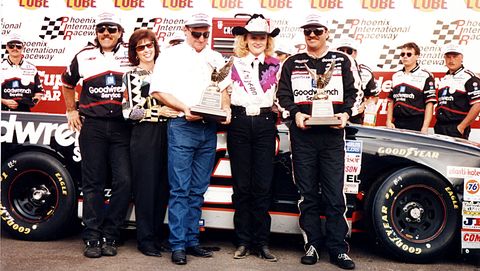
- Series originally named “SuperTruck Racing Series” became the third-highest NASCAR national touring level.
- The series featured American-made, full-size trucks, built specifically for racing.
- Series officially debuted on February 5, 1995, at Phoenix Raceway.
Ever since it was created, NASCAR and its commercial partners have celebrated the phrase, “Win on Sunday, sell on Monday.”
That applied to the cars fans would see on the racetrack competing each and every week. NASCAR’s sanctioning body wanted fans at the time to know they could own the same cars they saw racing, and manufacturers hoped fans would flock to a winning brand.
Up until the mid-90’s, the phrase only applied to automobiles. However, NASCAR president Bill France Jr. had an eye on a different segment of the vehicle market that he felt the series could stake a claim.
In 1994, France took particular notice in the rising sales of pickup trucks in the U.S. Soon thereafter, NASCAR made the announcement to introduce a third national touring series, a pickup truck racing series.
France told the Longview (Texas) News Journal, “We feel the time is right for a touring truck racing series. Trucks are extremely popular in the United States and sales figures show that one truck is sold for every two cars.”
And so, the “SuperTruck Racing Series” was born.
Word spread during the 1994 Winston Cup season, and the series began drawing interest from many different race teams across the sport. Championship-winning Cup Series car owner Richard Childress was asked for his thoughts on the new series and told the Longview News Journal: “The series looks very interesting. I think NASCAR’s decision to sanction the pickup truck series is definitely a real step forward for motorsports.”
Trucks were already in production and were based off original American pickups such as, the Chevrolet and GMC 1500, the Dodge 1500, and the Ford F-150. But of course, they were slightly modified for racing. The trucks were lowered, more aerodynamic, and powered by 358 cubic-inch motors. They were to weigh 3,400 pounds and have a 112-inch wheelbase.
In order to make sure things were right, and even give the fans a small taste of what was to come, NASCAR ran seven small exhibition races with the trucks in 1994 and into early ’95, all along the west coast. Tracks that held races included: Mesa Marin Raceway in Bakersfield, California; Portland Speedway, in Portland, Oregon; Saugus Speedway, in Saugus, California; and Tucson Raceway Park, in Tucson, Arizona. Three of the seven warm-up events were held in Tucson.
The sanctioning body gave the green flag for the 1995 debut season, which was slated for 20 races. The inaugural race was held at Phoenix Raceway Park on February 5, 1995, and was won by Mike Skinner. He would go on to win eight of the 20 races that season en route to the first championship.
The new series attracted all kinds of racers, from young up-and-coming stars to aging stars looking for a little more fun. Drivers giving the trucks a shot that year included A.J. Foyt, Rick Hendrick, Kevin Harvick, Darrell Waltrip, Ernie Irvan, Terry Labonte, Ken Schrader, Geoff Bodine, former NFL coach Jerry Glanville, and short-track legend Sammy Swindell.
Craftsman Tools signed on as the title sponsor for the series that was to officially become “The NASCAR SuperTruck Series presented by Craftsman.”
And since its inception, nearly two decades ago, the Craftsman Truck Series (it will be re-branded again in 2023) has become a vital stepping stone for young drivers. It’s a series of growth and gaining invaluable experience that separates the good and the bad and shows up-and-coming drivers part of what it takes if they are to become the Cup Series stars of tomorrow.
This news is republished from another source. You can check the original article here



